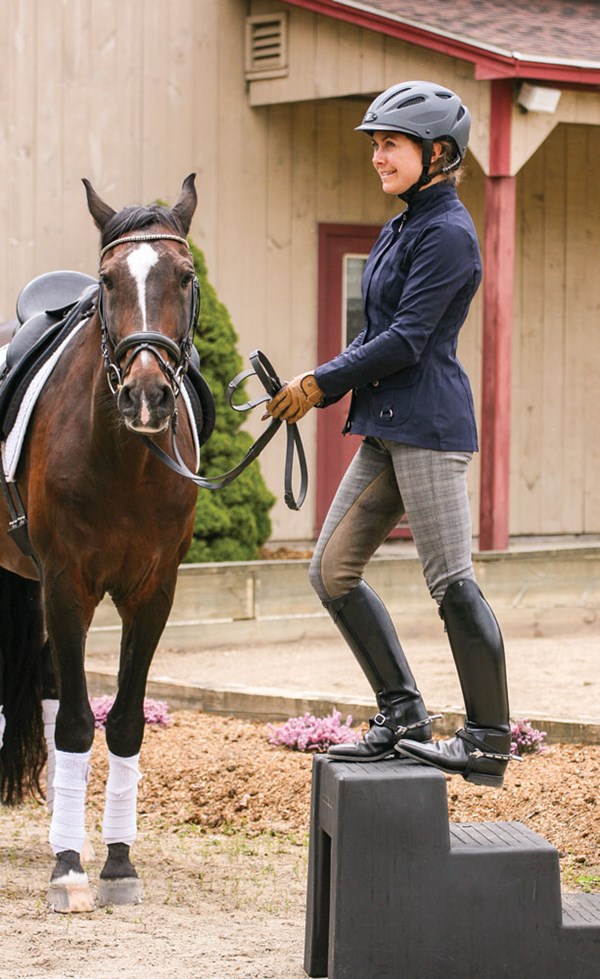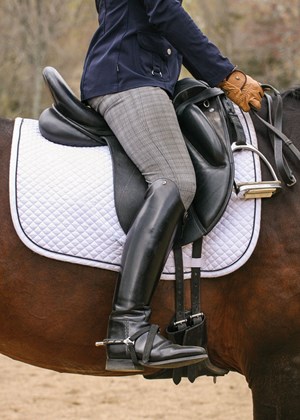A horse knows how to be a horse. A person needs to learn how to become a rider. A rider must ride in balance herself to create balance in her horse. When the rider can sit in a way that helps her horse move with better balance, then she has truly achieved something.
The rider should sit into the wave of her horse’s motion so she can influence his movement. If she sits on top of the horse, she is more of a passenger. For a rider to be able to influence the horse’s movement, the horse’s back must be warmed up and he has to be accepting of her leg and seat. Only then can the rider feel the wave of energy. Once the horse lets her in, he is in front of her leg and the half halts work to balance him, allowing the rider to be the trainer. Remember, the rider is always teaching the horse something and she must make sure that what she teaches is correct.
One major component that allows a rider to sit into the horse is learning how to use her absorbing joints. A good rider must let the horse’s energy go up into her absorbing and supple body and be quiet enough for that energy to go back down into her horse. Top riders can do this and appear still on top of a powerful moving horse. The only part of a rider’s body that should absorb the shock of the horse’s motion is her lower back, hips, knees and ankles. Sometimes we see a rider take the motion up into her elbows or even into her neck, which results in the “pecking-chicken” dynamic. The non-absorbing joints must be kept soft and quiet, allowing the energy from the horse’s movement to return back into the horse, thereby allowing him to move more brilliantly. If a rider allows the energy to go up into her upper body, it gets released into the universe, never to be gathered again. The rider’s job is to develop a supple low back, swinging hips and bouncy ankles.
Five Stretches to Increase Suppleness
1. Stair Stretches. This exercise helps make the ankle more flexible. The Achilles tendon is incredibly strong and needs to become supple to absorb the shock of the horse’s movement, especially in the sitting trot. Before getting on, stand on a mounting block and do stair stretches to help the calves, hamstrings and ankles release. This helps keep the stirrups from feeling too long.

2. Toe Writing. To help supple the ankle and create better nerve control, write the alphabet in the air with your toes.
3. Arm Circles. Big, backward arm circles help open the chest and slide the shoulder blades down the back where they belong. This can be done on the ground or while the horse walks on a long rein at the beginning of the ride. This exercise helps identify the rider’s core muscles and gets them warmed up for the ride.

4. Hip Stretches. This exercise helps address tight hips and hip flexor tendons, both common among riders. While seated in a chair, cross one ankle over the other knee and push the knee that is in the air gently downward to open the hip.
5. No Stirrups. In my experience, this is the fastest way to develop a great seat. When you ride without stirrups, flex the front of your calf and pull your toes up. Everything else should be hanging down, which will open the hips. Learn to let your hips swing with the movement of the horse.

I personally feel that every rider—whether Adult Amateur or professional—should go to the gym. Pilates, a personal trainer or other exercises can help you improve your riding by teaching better balance and improving fitness. Every day before I put my foot in the stirrup, I do a little yoga to stretch out my hips, legs, lower back, neck and chest. I find that this makes me physically and psychologically better prepared to hear my horse and approach the training in the best possible way. Working out will also help you understand what your horse goes through while learning how to use his body better and gain strength through dressage training.
Another awesome activity to improve body control is to take longe lessons. First, you will need a wonderful horse to do this successfully. Always make sure your instructor follows safety guidelines and that you are not wearing spurs. There are two types of longe lessons. The rider can either practice gymnastic exercises to develop the seat and independent aids or she can practice riding transitions within and between gaits without the use of the rein aids.
I think the first step in a longe lesson is to ride without reins and stirrups, which allows the rider to truly sit into the horse and swing with the horse’s movement. For a rider, learning the correct swing of her back and hips is challenging and takes lots of time and practice. She must always remember that the more she improves her seat and sits into the horse’s movement, the less she will rely on her hands for balance and interfere with her horse’s mouth.
I want my students to strive to become the best riders their horses can have. Stretching, exercising and practicing on the longe are all ways to improve the seat and body control. The horse should never be punished for reacting to a rider’s missed cues or accidental aids when her body is involuntarily reacting to his movement. A rider must keep a very high standard for herself to master her own body so she can always remain in beautiful balance and allow her horse to have joy and expression in his riding sessions.











